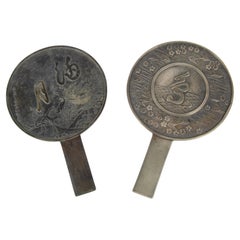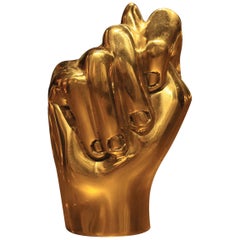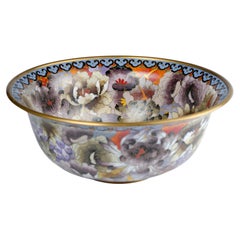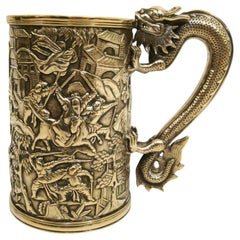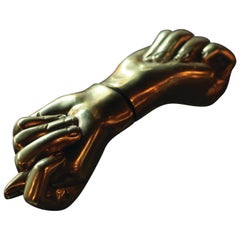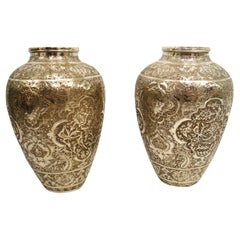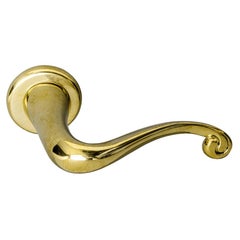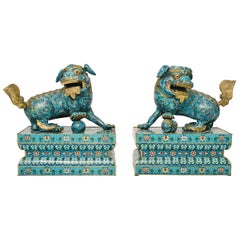South America - Metalwork
to
2
1,063
608
6
3
4
2
3
1
1
9
3
3
3
2
5
5
3
3
2
9
6
8
3
1
Item Ships From: South America
Set of 19th Century Meiji Era Ornate Etched Bronze Kagami Hand Mirrors, Japan
Located in North Miami, FL
Set of 19th century Meiji Era ornate etched bronze kagami hand mirrors, Japan
By: unknown
Material: bronze, copper, tin, metal
Technique: cast, molded, patinated, polished, metalwor...
Category
19th Century Japanese Meiji Antique South America - Metalwork
Materials
Metal, Bronze, Copper, Tin
Golden "Figa" Single Door Handle in Cast Brass by Estudio Orth
By Estúdio Orth
Located in Sao Paulo, BR
Contemporary golden handle, in cast brass.
Produced in São Paulo, Brazil.
This golden handle was meticulously handmade by master artisans one delicate piece at a time. It is therefo...
Category
2010s South American Brutalist South America - Metalwork
Materials
Brass
Chinese Cloisonne Bowl
Located in Buenos Aires, Argentina
Chinese Cloisonne Bowl
Bronze and enamel materials
made with Cloisonne technique
Origin China Circa 1950
Floral decoration
perfect condition
cloisone te...
Category
1950s Chinese Chinese Export Vintage South America - Metalwork
Materials
Bronze, Enamel
19 Century Chinese Export silver Dragon-Handled Mug / Tankard
Located in Buenos Aires, Olivos
19th Century Chinese Export Silver Mug / Tankard, the sides are beautifully decorated in relief with a scene of warriors in combat, very crisp and detailed, centering a shaped cartou...
Category
Mid-19th Century Chinese Chinese Export Antique South America - Metalwork
Materials
Silver
$2,280 Sale Price
40% Off
Golden "Figa" Contemporary Double Door Handle in Cast Brass by Estudio Orth
By Estúdio Orth
Located in Sao Paulo, BR
Contemporary golden handle, in cast brass.
Produced in São Paulo, Brazil.
This door handle was meticulously handmade by master artisans one delicate piece at a time. It is therefore...
Category
2010s Brazilian Brutalist South America - Metalwork
Materials
Brass
Pair of Antique Signed Islamic Ottoman or Persian Repousse Silver Vases
Located in Buenos Aires, Olivos
A fine Pair of Islamic silver vases.
Richly decorated with Ishafan (Eshafan) style repousse decoration throughout including gryphon heads, flowers & vines, birds of paradise, foliage...
Category
Late 19th Century Unknown Islamic Antique South America - Metalwork
Materials
Silver
20th Century/Shōwa Period Murashido Patinated and Polished Bronze Japanese Vase
Located in North Miami, FL
20th century/Shōwa period murashido patinated and polished bronze japanese vase
By: unknown
Material: bronze, copper, metal
Technique: murashido, cast, patinated, polished, metalwor...
Category
20th Century Japanese Showa South America - Metalwork
Materials
Bronze, Metal, Copper
Chinese Silver Card Holder Artist Lee Ching
By Leeching
Located in Buenos Aires, Argentina
Leeching Chinese silver card holder.
Solid silver card holder.
Origin China (Canton) Circa 1840 1870.
Signed on its base (stamp).
Canton manners...
Category
1850s Chinese Chinese Export Antique South America - Metalwork
Materials
Silver
$1,200 Sale Price
20% Off
"Primeiro" Contemporary Corkscrew in Cast Brass by Estudio Orth
By Estúdio Orth
Located in Sao Paulo, BR
Produced in São Paulo, Brazil.
This contemporary corkscrew in cast brass was meticulously handmade by master artisans one piece at a time. It is therefore quite difficult, if not ...
Category
2010s Brazilian Brutalist South America - Metalwork
Materials
Brass
Related Items
Polished Solid Brass Batlló door handle by Antoni Gaudi, 20th century design
By Antoni Gaudí
Located in Barcelona, ES
Solid cast brass with polished finish.
A company that has always attributed such great importance to the author of the designs could never forget the great figures in history. That is why the BD catalogue of contemporary creations has always included those by admired classical masters. Antoni Gaudí (1852/1926) is, without doubt, the most internationally well-known Spanish architect. But is not only his buildings and brilliant architectural solutions that have travelled the globe. His integrated conception of architecture led him to pay attention, not only to structural calculations, but also to all the decorative elements, including furniture, that would form part of the building. The admiration felt by modern designers for the furniture designed by Gaudí has not gone unnoticed by BD which was the first company to rescue them from history by embarking on their serial production using...
Category
21st Century and Contemporary Spanish Art Nouveau South America - Metalwork
Materials
Brass
$622
H 5.91 in W 3.94 in D 1.58 in
19th Century Chinese Cloisonné Fu Dogs
Located in Houston, TX
An exceptional palatial quality pair of 19th century Chinese cloisonné Fu dogs featuring gold gilding over copper.
Chinese cloisonné o...
Category
1890s Chinese Chinese Export Antique South America - Metalwork
Materials
Copper, Enamel
Antique Islamic Brass Bowl Fine Metalwork Hand Etched Bowl
Located in North Hollywood, CA
Antique Middle Eastern Islamic art Moorish brass bowl engraved with Thuluth Arabic calligraphy.The polished brass bowl is profusely chased with vines and vegetal motifs and inscribed with Islamic verses of the Holly Koran.This bowl has been professionally cleaned and polished.Measures: Diameter 7.25" x 4" height Mouth opening: 5".Great Middle Eastern brass metalwork decorative Islamic art objects.Handcrafted Moorish hand-etched Islamic metal brass bowl.Engraved, incised and hammered with very fine Arabic Islamic calligraphy writing and geometric designs on brass vessel.Very Intricate fine Middle eastern Moorish Islamic Art metalwork, museum quality artwork.Late 19th Century.Date of Manufacture: Circa 1880.Condition: Wear consistent with age and use.
Islamic brass metalwork is an intricate and beautiful form of art that originated in the Islamic world. It encompasses a wide range of decorative objects made from brass or other metals such as copper, bronze, and silver. Brass trays, in particular, are highly regarded for their craftsmanship and intricate designs.
Islamic brass metalwork has a rich history that dates back to the early Islamic period, with its roots in the metalworking traditions of ancient civilizations such as the Persians, Greeks, and Romans. However, Islamic artisans developed their own unique styles and techniques, blending elements from various cultures and creating distinctive motifs that reflected Islamic aesthetics and religious beliefs.
The process of creating brass trays involves several steps, each requiring specialized skills. Here is a general overview of the traditional techniques involved:
1) Design: A skilled artist or calligrapher creates the design for the brass object. Islamic brass metalwork often incorporates intricate geometric patterns, arabesques, floral motifs, and calligraphy inspired by Quranic verses or poetry.
2) Metalworking: The object is typically made from a sheet of brass or another metal. The metal is cut into the desired shape and then hammered or pressed to create the object. Traditional techniques such as repoussé (hammering from the reverse side) or chasing (hammering on the front side) may be employed to shape the metal.
3) Engraving: The surface of the metal is often decorated with intricate engravings or etchings. Skilled artisans use chisels, gravers, or other specialized tools to create fine details and elaborate patterns.
4) Filigree and Inlay: Some brass trays feature additional decorative elements such as filigree or inlay work. Filigree involves shaping thin wires of brass into delicate patterns and soldering them onto the tray's surface. Inlay work, on the other hand, involves embedding contrasting materials such as silver or copper into the brass, creating intricate designs.
5) Surface Treatment: After the main decorative work is complete, the tray may undergo surface treatments to enhance its appearance. This can include processes like polishing, buffing, or applying various chemical patinas to create an aged or oxidized effect.
While this bowl has certainly witnessed the passage of time, it remains in remarkably good condition, with only minor signs of age that add character to its appearance. The patina on the brass enhances its antique allure, making it a truly authentic and captivating collectible.
Arabic Calligraphy: The Arabic writing on the bowl is a work of art in itself. The calligraphy showcases the mastery of the scribe's hand, with flowing curves and intricate details that form an elegant script. The script may include Quranic verses, blessings, or poetic verses, depending on the bowl's origin and purpose. The inscriptions are not only visually striking but also carry profound meaning, making this bowl a beautiful representation of Islamic heritage.
Intricate Patterns: In addition to the Arabic calligraphy, the bowl features intricate geometric patterns and motifs that further enhance its visual appeal. These patterns are a hallmark of Islamic art and reflect the mathematical precision and artistic creativity that defined Islamic craftsmanship.
This antique Islamic brass bowl...
Category
19th Century Turkish Islamic Antique South America - Metalwork
Materials
Brass
Antique 19th Century Ottoman Islamic Tombak Gilt Copper Nargile Hookah Turkey
Located in Portland, OR
A fine & rare antique 19th Century Ottoman Tombak (Gilt Copper) Nargile or Hookah pipe, Turkey, circa 1850.
A nagile or hookah pipe's history dates back...
Category
1860s Turkish Islamic Antique South America - Metalwork
Materials
Copper
$2,963 Sale Price
24% Off
H 20 in Dm 8 in
Chinese Black Enamel Cloisonné Chrysanthemum Flower Vase
Located in New York, NY
Chinese black enamel cloisonné and brass ginger jar vase with chrysanthemum flowers, dogwood flowers and a butterfly and beautiful rich colors.
Hand crafted on solid brass.
Category
20th Century Chinese Chinese Export South America - Metalwork
Materials
Enamel
Chinese Export Silver Dragon Spoon by Wang Hing & Co., Late 19th Century
By Wang Hing & Co.
Located in Austin, TX
A very fine and charming Chinese export silver spoon in the form of a dragon, by Wang Hing & Co., Qing Dynasty, late 19th century, China.
...
Category
1890s Chinese Chinese Export Antique South America - Metalwork
Materials
Silver
$1,200
H 0.88 in W 5 in D 1 in
Islamic Indo Persian Kulah Khud Helmet with Arabic Inscription
Located in North Hollywood, CA
Islamic Indo Persian kulah khud helmet with Arabic hand engravings.
Hand forged, made of heavy tinned copper metal Middle eastern influence warrior helmet ...
Category
Early 20th Century Indian Islamic South America - Metalwork
Materials
Metal, Steel
6 Antique Chinese Cloisonne Teapots
Located in Brea, CA
Collection of 6 Chinese cloisonne teapots in varying shapes and designs of flora and fauna. The highest one is 5.5'' H x 2 W x 2.5'' D. the sm...
Category
20th Century Chinese Chinese Export South America - Metalwork
Materials
Bronze
Japanese Meiji Period Sterling Silver 2 Handled Basket by Katsu Miyamoto
By Miyamoto Shoko 1
Located in Dallas, TX
PRESENTING a GORGEOUS, VERY HIGH QUALITY and EXTREMELY RARE piece of Japanese Meiji Period Sterling Silver 2 Handled Basket by Katsu Miyamoto.
EXQUISITE, EXCEPTIONAL, RARE & IMPORTANT!
This is definitely a Meiji Period piece due to the fact that it is marked with the sterling silver mark “jungin”.
The Meiji period was from 1868 to 1912 and in 1928 a law was introduced in Japan compelling the use of decimal marks for silver.
This pre-dates that decimalization law.
We are of the opinion that it is from circa 1900.
Miyamoto Shoko was founded in 1880 as the first silverware specialty shop. In 1899, Miyamoto Shoko’s silverwares were ordered by the family members of the Emperor of Japan, and to this day, they are making fine and graceful handicrafts with skillful craftsmen.
Loved by numerous customers since the Meiji era, Miyamoto Shoko’s products have also been given to Princess Mako and Princess Kako of Akishino, as well as Princess Aiko Toshinomiya, on their birthdays.
Katsu Miyamoto (宮本勝), in 1880, in order to increase the sales of tobacco and cigarettes to foreigners founded the Moyamoto Shoko company, which produced different silverwares in general and particularly silver cigarette cases. Miyamoto’s first name, Katsu (勝) in some sources is written as “Masaru”, since 勝 kanji can be pronounced in both ways.
This basket is of the HIGHEST QUALITY imaginable!
The top of the basket has the MOST GORGEOUS repousse work of flowers, probably lotus flowers, with leaves and foliage. It has an underlying chevron effect chasing, reflecting parquetry.
The 2 handles are cast in the form of bamboo handles.
The rim of the top likewise is cast as bamboo.
The base is equally stunning in a different way!
It is chased with a chevron effect, like parquetry flooring and the four feet simulate pieces of sliced bamboo with an interlinking gallery of support columns, likewise, simulating bamboo.
The QUALITY of WORKMANSHIP is OUTSTANDING!
The pieces weighs exactly 525 grams.
This piece takes my breath away!
This is one for the SERIOUS COLLECTOR of EXQUISITE AND RARE Japanese silver. You will not find another like it, for sale ANYWHERE ELSE IN THE WORLD …… I know as I have searched!
Provenance: Acquired from a Dallas Private Collector.
Dimensions: 9.6 inches wide, 7.6 inches deep and 2.75 inches tall ( 7.25 inches tall with handles up)
Condition: Very good. It looks like the base 4 legged gallery, has been repaired/re-attached to the base, but otherwise it is excellent and of Museum quality.
The Meiji period (明治時代 Meiji-jidai?), also known as the Meiji era, is a Japanese era which extended from October 23, 1868 through July 30, 1912.[1] This period represents the first half of the Empire of Japan during which Japanese society moved from being an isolated feudal society to its modern form. Fundamental changes affected its social structure, internal politics, economy, military, and foreign relations. The period corresponded with the reign of Emperor Meiji after 1868, and lasted until his death in 1912. It was succeeded by the Taishō period upon the accession of Emperor Taishō to the throne.
Solid silver pieces...
Category
Early 20th Century Japanese Meiji South America - Metalwork
Materials
Sterling Silver
$7,250
H 7.25 in W 9.6 in D 7.6 in
Large Chinese Cloisonne Enamel Bowl, Qing Dynasty
Located in Vero Beach, FL
Large Chinese Cloisonne enamel bowl, Qing Dynasty
Exceptional and finely decorated Chinese cloisonne punch bowl with gilt
metal foot and rim. The bowl has slightly flaring sides ...
Category
Early 20th Century Chinese Qing South America - Metalwork
Materials
Copper, Enamel
Bronze Plate Japan Meiji Era 1868-1912
By Non-Standard Furniture and Lighting
Located in Milano, IT
Bronze plate decorated with scene of lohans "enlightened disciples of Buddha" engaged in various prayer tasks in a river landscape of lotuses and birds. The figures of monks rendered...
Category
1890s Japanese Meiji Antique South America - Metalwork
Materials
Bronze
Chinese export Silver Tray, 19th Century
By Zee Wo
Located in Roma, IT
Chinese silver tray is an original decorative object realized in China between 1870 and 1930.
Original silver object.
Hallmark Shangai, silversmi...
Category
19th Century Chinese Antique South America - Metalwork
Materials
Silver
Recently Viewed
View AllMore Ways To Browse
Bronze Elephant Incense
Dallah Arabic Coffee Pots
Brass Arabic Coffee Pot
Bronze Asian Charger
Bronze Temple Bowl
Chinese Bronze Ding
Foo Dog Incense Burners
Japanese Bronze Vase With Silver Inlay
Japanese Koro Silver
Large Japanese Bronze Incense Burner
Antique Cast Iron Kettle
Chinese Cloisonne Charger
Chinese Deer Bronze
Copper Dallah
Japanese Komai
Middle Eastern Dallah Arabic Coffee Pot
Ming Censer
Namikawa Sosuke
